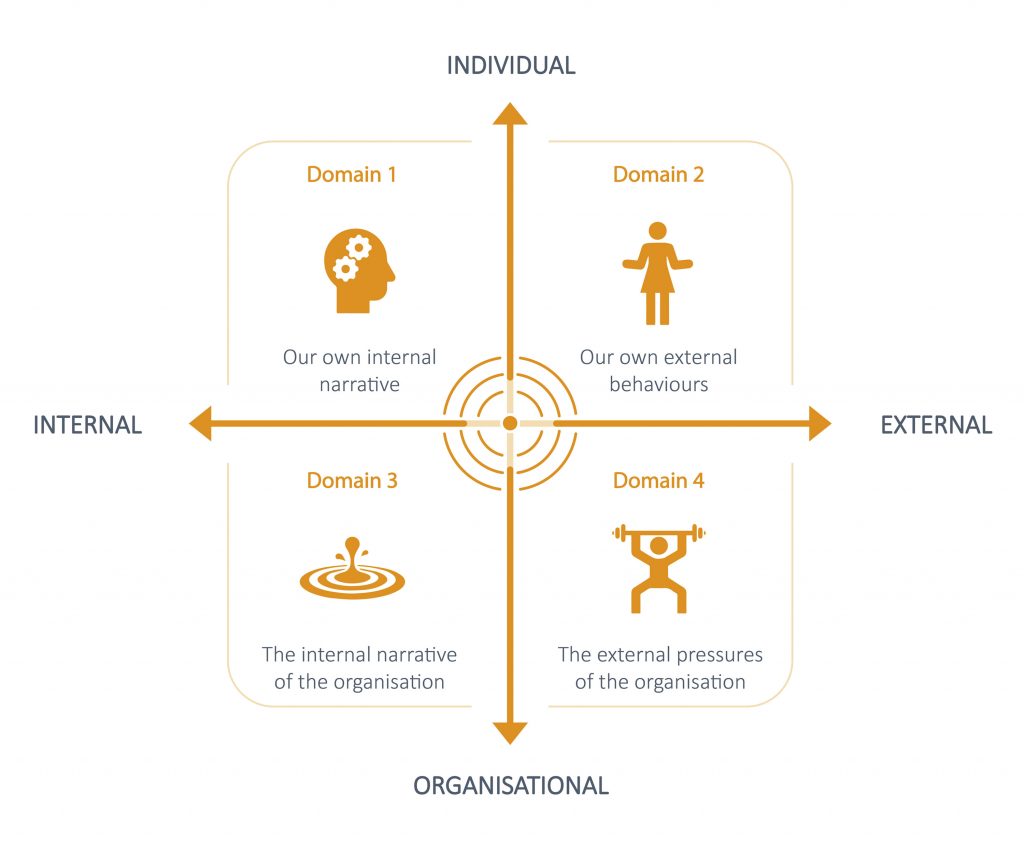Putting Burnout in the Crosshairs
Jack, not his real name, is in the midst of a perfect storm. He recently stepped into a new, more senior and significantly more demanding leadership role within his organisation. The appointment comes hard on the heels of major, disruptive changes in his home life. All of this is on top of the seismic stress-inducing shifts created by the global pandemic. The cumulative effects of all these changes have left Jack feeling depleted, exhausted and struggling to remain effective in his role.
Jack was demonstrating the classic symptoms of burnout, a phenomenon that is increasingly showing up across the business landscape.
Burnout, the new crisis
In May 2019, the World Health Organisation (WHO) recognised burnout as a specific workplace condition.
The WHO defines burnout in this way:
“Burnout is a syndrome conceptualised as resulting from chronic workplace stress that has not been successfully managed. It is characterized by three dimensions: 1) feelings of energy depletion or exhaustion; 2) increased mental distance from one’s job, or feelings of negativism or cynicism related to one’s job; and 3) reduced professional efficacy.”
In Australia alone, 21% of people take time off due to mental health issues, costing business an estimated $10.9 billion in absenteeism and presenteeism.
The cost to Jack’s business of his stepping away is significant. He is what we would describe as a “key person risk”, in other words, his contribution to the business is so vital that his long-term absence would materially impact the health of the business.
Jack’s CEO was quick to recognise the indicators of burnout and the potential cost of not tackling the issue. She suggested that Jack take a 3-month paid sabbatical to reset and recharge. Jack declined.
Jack’s story is an example of a growing body of research which says that addressing burnout – an issue brought into sharp focus by the global pandemic – needs both an individual as well as an organisational approach. For example, Jack needs to enhance skills like practicing resilience and managing his workload. But those solutions are going to be a band-aid fix unless the organisation is simultaneously addressing the other root causes of Jack’s burnout.
To underscore the point, a recent global study published in the Harvard Business Review shows that burnout has six main causes – some are individual, some are organisational:
- Unsustainable workload
- Perceived lack of control
- Insufficient rewards for effort
- Lack of a supportive community
- Lack of fairness
- Mismatched values and skills
Target the Root Cause, not just the Symptoms
What we are observing is that many organisations are taking a general approach to burnout, helping individuals deal with the symptoms, rather than diagnosing, targeting and addressing the root causes.
To help our clients take a more holistic diagnostic approach to burnout, we developed a ‘Diagnostic Crosshairs model. By exploring four domains of how an individual intersects with an organisation, leaders can identify (or prioritise) which of these four “categories” of root causes are the source of the burnout for each person on their team.
Domain 1: Individual / Internal (Cognitive, Emotional, psychological)
This domain represents our internal dialogue with ourselves within the context of the workplace. If the root cause of burnout is in this domain, it can be addressed successfully simply by coaching someone to perceive, interpret and respond to situations differently — for example by providing them with strategies to ‘reframe’ situations to overcome a perceived lack of control.
Domain 2: Individual / External (Physical, Behavioural)
This domain represents our behaviours. If the root cause of burnout is this domain, it can be addressed by coaching someone to build physical capacity or ability to manage the stressors that lead to burnout — for example, by learning to be more effective in saying “no”.
Domain 3: Organisational / External (Systems, Structures, Processes)
This domains represents how organisational systems, structures or processes impact us. If the root cause of the burnout is in this domain it can be addressed by making changes to the systems, structures or processes — for example, by making decision-making processes simpler and reducing the number of meetings.
Domain 4: Organisational / Internal (Culture)
This domain represents the internal ‘narrative’ of an organisation, i.e. cultural norms, values, priorities; the way we do things. If the root cause of burnout is in this domain it can be addressed by challenging unhealthy cultural norms or accepted ‘ways of working’ — for example, eliminating late-night email requests.
Solving the Burnout Conundrum
There’s no question that the global pandemic has exacerbated the challenges of burnout. Yet our view is that the burnout crisis will outlive the pandemic. That’s because there’s no sign of a let up in the underlying stressors caused by the speed of execution, unrelenting change, volatility and uncertainty.
One the reasons our businesses, the Stephenson Mansell Group and Alchemy merged was that we recognised that to provide solutions for the current and future challenges of leadership – like the current burnout crisis – requires bringing together the right expertise.
Tackling burnout holistically draws on organisational psychology, systems thinking, strategy execution, human behavioural change as well as a deep understanding of the commercial drivers of success.
As we are discovering with Jack’s organisation, there are no quick fixes to the burnout problem, but when you surface the issues through open and honest conversations you are on the path to a solution.

Mehul Joshi is a former award-winning BBC journalist and is now a sought-after consultant and executive coach in leadership development and employee engagement, with career spanning three decades and four continents. He is a regular contributor on the subject of leadership for publications such as the Australian Financial Review.

Virginia Mansell is an Organisational and Clinical Psychologist and founding Partner of SMG. With 35 years’ experience in the HR and professional development sector, she has been at the forefront of the executive coaching and leadership development profession, including working with many Australian blue-chip companies.
Christopher Paterson is Managing Partner at SMG. With a background in business psychology and three decades of experience on the global stage, Christopher specialises in behaviour change on an individual and organisational level.









